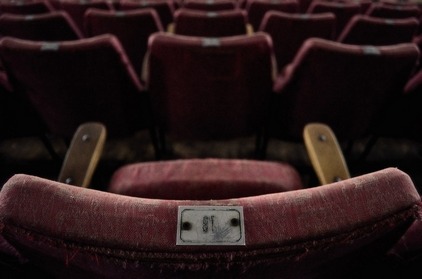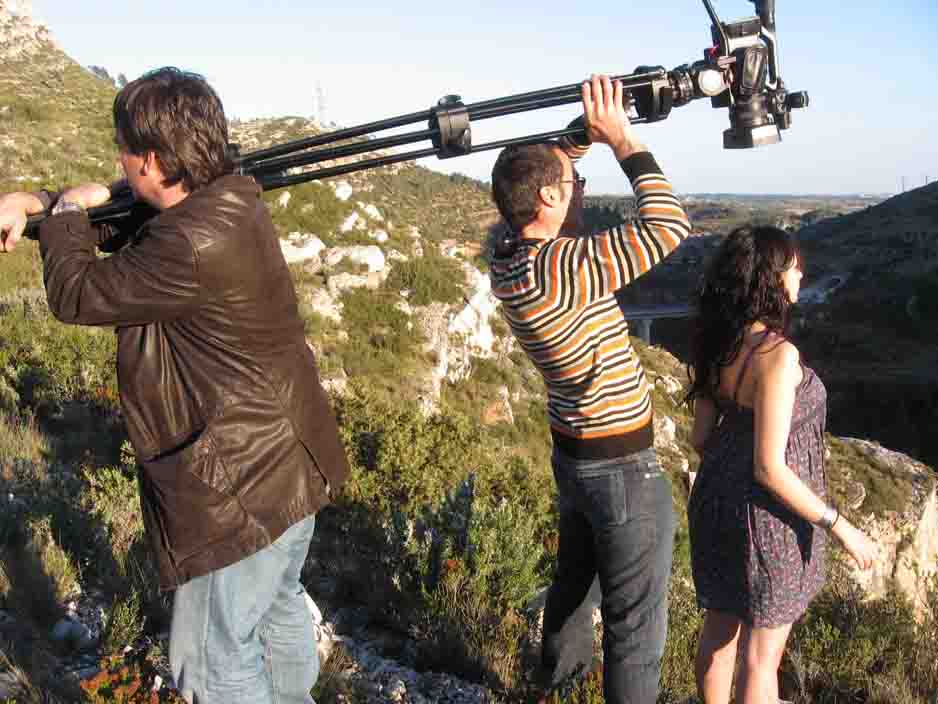nits en blanc 
un espai literari d'històries que ens uneixen i d'altres coses...
Cinerama to digital cinema: from the zenith to the decline

Enric Mas (http://nitsenblanc.cat) |
January 11, 2016 |
|---|
I try to imagine what the audience felt when they first saw a movie in Cinerama... but I cannot. I wonder, did they feel the same as I did when I saw a projection in 70 mm IMAX for the first time? Some clues tell me the answer is no. Howard Rust, of the International Cinerama Society, gave me an initial clue: “I was talking to a chap the other day who’d just been to see IMAX. ‘Sensational’, he said. ‘But, you know… it still doesn’t give you the same pins and needles up and down the back of your spin that Cinerama does’ ”.1 What is its secret? Why is every film seen in Cinerama a unique event that is remembered for decades?
We have another clue in a man who had worked with D.W. Griffith in That Royle Girl (1925), who produced and directed technically innovative short films, where black performers appeared, a rarity at the time, including the first appearance of Billie Holiday (Symphony in Black: A Rhapsody of Negro Life, 1935). He created a new imaging system (Vitarama) for the World’s Fair in New York (1939), joining 11 projectors of 16 mm, which reached a vertical image of 75 degrees high and 130 degrees wide,2,3 developments which led to the most advanced artillery simulator in the world, which was used to train future aircraft gunners in World War II.4 This man’s name was Fred Waller.
We have more clues in Waller’s other collaborators: Hazard Reeves, a sound engineer who helped popularize the use of quartz crystals for radio transmitters and incorporated a stereo system5 (in a 7-channel format) into Waller’s idea; Lowell Thomas, a writer, speaker, and traveler who filmed the legendary T.E. Lawrence (Lawrence of Arabia) in the Palestine campaign during World War I;6 Michael Todd, a producer, who after leaving the Cinerama project, created the Todd-AO system with American Optical, (with a projection of 70 mm and 6 audio channels)7 to try to compete with Cinerama; Merian C. Cooper, an aviator, adventurer, writer, producer and director (to name a few things), known for innovations in King Kong (1933) and the first film in Technicolor (Becky Sharp, 1935). He directed This Is Cinerama (1952), the first film in the Cinerama system.1,2,8
If we try to imagine all these innovators together in a single project, we will begin to understand why Cinerama is so important. This system arose in response to the loss of viewers at the cinema and the fight with television. And the response was overwhelming. The Cinerama system consists of three 35 mm projectors that project to 26 frames per second (fps) to improve stability, a screen aspect ratio of 2.65:1 (the relationship between its width and its height) in a curved screen9 with an image that includes a 146º visual field and 7 multi-channel sound.10 If we imagine an audience accustomed to watching films on an almost square screen (1.33:1), mostly in black and white and mono sound, we can deduce the impact on the viewer. But there is something more than that. Fred Waller was obsessed with reproducing the full range of human vision in a motion-picture experience. He created film cameras with 27 mm focal length lens, which are a very close approximation to the focal length of the human eye; the screen is curved at the same radius as the human retina; the camera lens had the same size than a contact lens of that time (rigid); and the projection covers had a 146º horizontal angle of view, which was very similar to the visual field of the human eye.1,11
Logically, the technical difficulties of production, filming and editing did reduce Cinerama footage and screenings. But first, coinciding in time, studies began a battle to try to match the Cinerama formats: the aforementioned Todd-AO, Super and Ultra Panavision 70, VistaVision, Technirama and Super Technirama 70... and the best known: CinemaScope (1953), which developed a system created by Henri Chrétien in 1929, using anamorphic lens (manufactured by Panavision, Inc.), which were placed in front of the camera and cinema film projector.7 It was the result of a compromise between traditional film production, mainstream cinema and projection display techniques. Exhibitors from theaters and many critics called CinemaScope “a poor man’s Cinerama”,1,12 however it triumphed nonetheless. The reasons: an aggressive strategy by Twentieth Century Fox to impose it... and the press, with critics such as Bosley Crowther of the New York Times that found it “similar to Cinerama”8 (!?). An estimated 200 to 350 cinemas per week converted to CinemaScope and by April 1954, 3,500 were already installed. In mid-1955 it was 13,500.7 The industry adopted Panavision (a modification of CinemaScope with new lenses) as a standard in 1959.7
All of this would be history if it were not that history, again and again, is repeated. Digital cinema (Digital Light Processing, DLP), invented by Texas Instruments, was introduced in 1997. It had a resolution of 1280x1024 pixels, which were distributed across a huge screen. This sounds like a very low resolution. Even Wikipedia recognizes that it “used limited 1280×1024 resolution”.13 Later an endless list of projectors arrived along with attempts to improve the resolution, which ended with the introduction of 4K (4096x2160 pixel resolution). With regard to this, websites dedicated to 4K recognize that “70mm Imax projection also beats out 4K projection in terms of sheer resolution, creating something closer to 8K in quality” (which is not twice, but much higher) and that “the difference between 70 mm Imax screens and just about anything else truly is noticeable”.14 Also, again, these are journalists and supposed experts. In a newspaper article Quim Casas, critic and writer specializing in cinema, said the following statement: “Converting old celluloid to digital disk has undeniable virtues [...] At the same time, resolution increases. The reels of a 35 mm camera are equivalent to more than 20 megapixels, while high-definition films do not reach three megapixels. Therefore, the viewing quality increases”.15 I ask myself: since when is 3 more than 20 (3> 20)? All is fair when imposing a new format right?
As director Steve McQueen has said, why try to imitate what you already have? The same answer lies behind most of Hollywood’s riddles: money. The USA box office reached 11 billion dollars in 2013, which was split roughly 50-50% between a few studios and thousands of theater operators (many of which rely on fast food and drink sales to increase profits).16 And digital cinema represents, at least in theory, reduced costs in production and sending copies of films to theaters. Here is the key. The big studios do not care whether the resolution is higher in the negative, or whether the sense that viewer perceives is much real with traditional film, or whether digital cinema looks pixilated or tires the viewer. People like McQueen know it and prove it when they say bluntly that “all this technology, it’s changing every five minutes, because someone’s making some money out of it” and he adds about reel-to-reel film: “There’s something romantic about film. Some sort of magic—it’s almost like it breathes. Film feels much more... I don’t know. Maybe ‘human’?”16 Obviously there are many more things to the viewer than the resolution or the dark side of the industry: there are many details and feelings that seem imperceptible, but they are there, and the viewer catches them in each projection.
This context helps to explain why a group of cinema’s best directors is struggling to preserve reel-to-reel film (either 35 or 70 mm). Directors Christopher Nolan and Quentin Tarantino are some of the best known. Tarantino, at Cannes in 2014, said: “digital projection and DCPs is the death of cinema as I know. […] Digital projection, that’s just television in public — and, apparently, the whole world is OK with television in public, but what I knew as cinema is dead”.17 And further: “We have ceded too much territory to the Barbarians”.17
Something important has happened. We know this story that we have been able to hear. Because it has happened with music, photography, have tried with books, and now it’s the movies. In my essay “The means are justified themselves: as you know, Franz?” (“El mitjà es justifica a si mateix: com ho sabies, Franz?”)18 I related this fact with music and photography: “In trivializing a format (CDs due to MP3s), they have made people assume that they no longer need to buy CDs. The psychological effect is terrible. I no longer ‘buy the CD’, I don't need it, now I just ‘buy the music’. However people, being so accustomed to materialism that we no longer remember the romance of the little things, we assume that if something is not being sold in a physical format, they are selling us smoke. Therefore, if I no longer need CDs, I don't need the stores where they sell them either and ultimately I don't need to buy the smoke of what is the MP3 if a friend can get it for me or I just download it myself. And smoke without containing is very easy to achieve: the only thing you need is fire. [...] The situation with photography is identical [...] If you do not need negatives you no longer need a place to develop them; you do not need photo albums because you send them through the Internet; not even a storage media to give the photos to a friend. And finally, you do not need a camera because your smartphone can solve everything”.19
Similarly, Christopher Nolan also refers to this format trivialization affecting film asserting that “‘Content’ can be ported across phones, watches, gas-station pumps or any other screen, and the idea would be that movie theaters should acknowledge their place as just another of these ‘platforms’ ”.19 He continued: “This bleak future is the direction the industry is pointed in, but even if it arrives it will not last”.19 His prediction is that with the current evolution of the industry, films will be seen mainly at home, with the few surviving theaters being relegated to hosting events for films focusing on fans or franchises.19 A future situation that I as well think is (unfortunately) probable.
Claiming that the public knows the background of these issues is possibly an illusion. There is one aspect, however, that puzzles me: why people who are supposedly experts, such as critics, filmmakers, collectors, and above all those around us who always want to be updated, why do they not want to accept the truth? Why are experts so biased? They do not realize that everyone was dragging a mistake that not only have done before, but again do. They have all contributed to this. I remember colleagues saying that the CD was the solution for music. They were raised for that invention. Then they themselves were amazed with the MP3... and then they stopped buying music. Meanwhile, we bought some (and are buying) vinyl. The case of photography is identical. Such technological developments to only end up taking a selfie using a mobile phone and uploading it to the Internet in a compressed format? There is a gap between the supposed experts and true lovers of art: the experts think they know the truth imposed and assume it as their own, the latter know that art expresses the truth itself.
In all this, there is hope. Expertise and new ideas are few. In Barcelona, a city that I know minimally, there are options such as the bistro-cinema called Zumzeig, the Texas theaters and the “Phenomena Experience” theater are some of the solutions to the digital war, which as we have seen, will soon end. The Zumzeig bistro-cinema combines programming of films and documentaries that are difficult (if not impossible) to see anywhere else. The theater has a taste for films in their original version and the possibility of projecting 16 or 35 mm, with events such as presentations by producers and directors. What a good idea: if you are the only one that shows a film, you don't have competition. If we also add the fact that you can sit in their bistro in the exit with friends to chat about the film, now we have a good plan to spend the afternoon and we have beaten the multi-screen cinemas (why program the same commercial film in four identical screens if other multi-screen cinemas are doing exactly the same?). Cinemes Texas is a revival house at an affordable price, with original versions and an awareness of the state of cinema (is it a coincidence that there was a Steve McQueen film and Catalonian films at its inauguration?). The Phenomena Experience Theater is definitely another very special case: releases, revivals, showings in 35 and 70 mm, original versions, seasons, a catalogue worthy of the best film libraries... In fact, it is the only theater in Spain that will show Tarantino’s latest film, The Hateful Eight, under the conditions set by the director (in 70 mm and Ultra Panavision). That says it all: I already know where I’ll go to see it.
For all those geeks who think they know the truth about digital cinema, they now have the opportunity to open their eyes (also literally). It’s easy: go see The Hateful Eight in 70 mm and Ultra Panavision and then in digital cinema (in 4K, if you want). If possible, sit at a similar distance from the screen on both occasions. So, at least, we avoid the evil (and destructive) habit of not verifying for ourselves the things we say, whether in the media, where supposed experts speak, or even that relative or friend that seems to say things that are besides the point.
References
1 Strohmaier D, director. Cinerama Adventure [DVD]. Burbank (CA): C.A. Productions and Turner Entertainment; 2008.
2 Ballio, T. The American Film Industry. Revised ed. Madison, Wisconsin: University of Wisconsin Press; 1976. p. 427-428.
3 Waller F. The Entire Development of the Cinerama Process. Letter to Mr. W. L. Laurence, NY; 1950 March 31. Available from:
http://www.in70mm.com/cinerama/archive/story/index.htm
4 Waller F. The Waller Flexible Gunnery Trainer. Presented at the technical converence in New York, NY; 1945 Oct 15. Available from:
http://in70mm.com/cinerama/archive/gunnery/index.htm
5 Hazard E. Reeves, 80; Popularized Cinerama. The New York Times. 1986 Dec 31. Available from:
http://www.nytimes.com/1986/12/31/obituaries/hazard-e-reeves-80-popularized-cinerama.html
6 Lowell Thomas and Lawrence of Arabia. A Legacy of Ripples. Clio Visualizing History Page [Internet]. [cited 2016 Jan 4]. Available from:
http://www.cliohistory.org/thomas-lawrence/legacy/
7 Neale S, Smith M. Contemporary Hollywood Cinema. London: Routledge; 1998. p. 111-114, 117.
8 Lev P. The Fifties: Transforming the Screen, 1950-1959 (History of the American Cinema, vol. 7). Berkeley: University of California Press; 2006. p. 113-119.
9 The aspect ratio changes according to sources:
Martin Hart cites an aspect ratio between 2.59:1 and 2.65:1. Available from: http://www.widescreenmuseum.com/widescreen/cinerama_specs.htm.
The webpage The Letterbox & Widescreen Advocacy Page cites an aspect ratio of 2.60:1 for Cinerama. Available from:
http://www.widescreen.org/aspect_ratios.shtml.
Peter Lev (8, p112) confers an aspect ratio of 2.72:1 to Cinerama.
I decided, therefore, to choosetheaspect ratiointermediatequoted byMartinHart (2.65:1).
10Some sourcesmention8sound channels (8, p112).
11Kimble G. How The West Was Won – in Cinerama. American Cinematographer. 1983 Oct; 64(10):46. Available from:
http://in70mm.com/news/2002/west/index.htm
12 Belton J. Glorious Technicolor, Breathtaking CinemaScope, and Stereophonic Sound. In: Balio T, editor. Hollywood in the Age of Television. London: Routledge; 2014. p. 195-200.
13 Wikipedia contributors. Wikipedia. The Free Enciclopedia[Internet]. Digital Cinema. [updated 2016 Jan 4; cited 2016 Jan 4]. Available from:
https://en.wikipedia.org/wiki/Digital_cinema#Technology_and_standards
14 70 mm Imax, 35 mm, 2K or 4K Digital: Which is the better movie format. 4K.com [Internet]. Santa Monica: 4K.com. 2014 Nov 25 [cited 2016 Jan 4]. Available from:
http://4k.com/news/70mm-imax-35mm-2k-or-4k-digital-4281/
15 Casas Q. Hitchcock, en alta definició. el Periódico. 2012 Apr 3. p. 48-49. Available from:
http://www.elperiodico.cat/ca/noticias/oci-i-cultura/hitchcock-alta-definicio-1616996
16 Alexander H, Blakely R. That’s all, folks: what the end of 35mm film means for cinema. New Statesman Magazine. 2014 Aug 27. Available from:
http://www.newstatesman.com/2014/08/s-all-folks
17 Newman N. Quentin Tarantino Pronounces the Death of Cinema, Longer ‘Django’ & More at Cannes Press Conference. The Film Stage: your spotlight on cinema [Internet]. 2014 May 23 [cited 2016 Jan 4]. Available from:
18 Mas E. El mitjà es justifica a si mateix: com ho sabies, Franz?. Nits en blanc [Internet]. 2015 Nov 14 [cited 2016 Jan 4]. Available from:
http://nitsenblanc.cat/Histories_publicades/El-mitja-es-justifica-a-si-mateix.pdf
19 Nolan, C. Christopher Nolan: Films of the Future Will Still Draw People to Theaters. The Wall Street Journal [Internet]. 2014 Jul 7 [cited 2016 Jan 4]. Available from:





